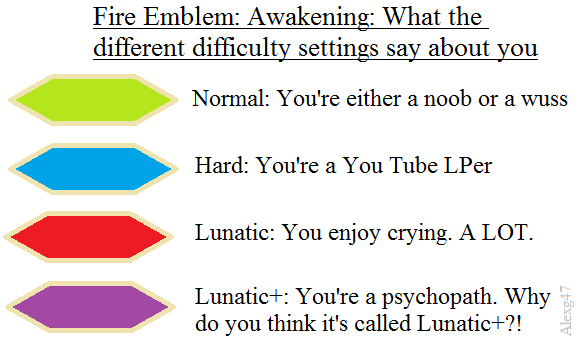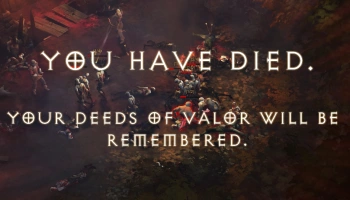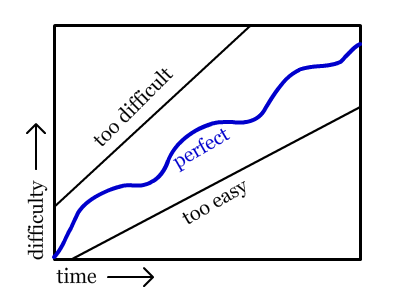
- Which games have Hard Modes that can actually be called “Hard Mode”. Which “Hard Modes” are actually just Normal +?
- How well does each game cater to different skill levels?
- Which games are great for a newcomer to start out with?
- How would you rank the difficulty settings from hardest to easiest?
So without further ado let’s begin:
Which games have Actual Hard Modes:

Thracia 776: Technically it doesn’t have a Hard Mode, but for reasons I’ll get into later this game’s difficulty is above average in comparison to the typical Fire Emblem game. I don’t count Paragon Mode as a different difficulty setting since it doesn’t address the parts of Thracia that are often considered difficult. A lot of the difficulty stems from how user unfriendly it is. If you’re not playing blind then this game gets significantly easier. Then again, you could say the same thing about the vast majority of the series.
Binding Blade: Hard Mode does not mess around in this game. Enemies are powerful enough to take seriously and the game hands the player an army of scrubs that make the game even more challenging.
Shadow Dragon: I’ve heard interesting things about H5. I’ve never played it so I could be completely off but H5 is usually considered difficult until warp-skipping occurs. To be fair, the same could be said of Thracia 776 and that game made it here.

New Mystery of the Emblem Maniac Mode - Reverse Lunatic: Perhaps I just need to “get good” but Maniac mode of FE 12 for me has always been significantly harder than 90 % of the series. Enemies are strong enough to actually kill you, resource management is actually required and enemy stat inflation exists. It’s still significantly easier than Lunatic or Reverse Lunatic due to the presence of Warp.
Lunatic and Reverse Lunatic involve enemies who will actually cap their stats and wield forged weapons on a regular basis. Reverse Lunatic Mode gets my vote for most challenging difficulty setting in the series because it has everything that made Lunatic mode ridiculous, but this time around enemies get to attack first even if the player initiated the attack.
Conquest Hard & Lunatic: Yep. Conquest succeeded at actually being really challenging. Enemy stats are powerful from the get-go, Dual Strike tends to help enemy formations A LOT, debuffs and status staves can throw the player for a loop. Unfortunately the endgame of Lunatic mode starts to veer into bs territory.
______________________________________________________
How Well Does Each Game Cater to Different Skill Levels
Fire Emblems 1 - 5: I’m lumping these games together because in this category they’re practically the same. They only have one difficulty setting and with the exception of Thracia 776 they’re not very difficult.
Fire Emblems 1 & 2 are at that weird phase where they’re not difficult enough to be considered an outright challenge, but they’re also as easy as Sacred Stones or Path of Radiance. Fire Emblem 3 Book 2 is borderline Sacred Stones and Path of Radiance levels of easy but it lacks the modern bells and whistles that newcomers might come to expect out of Fire Emblem. Holy War tries to have moments of difficulty but overall it’s pretty easy to stomp through. Holy War’s even easier than Fire Emblem 3 Book 2. Thracia actually appeals to the hardcore part of the fan-base but because of how user unfriendly it is only the hardcore vets will like it.
Binding Blade: For a game with only two difficulty modes this game does a pretty good job catering to different skill levels. Hard Mode is actually challenging so it can appeal to more experienced players while Normal Mode caters to players with lower skill levels. The only skill level that Binding Blade doesn’t cater to are newcomers who’ve played few to none of the games.
Fire Emblem 7 - 9: These games are great installments to introduce newcomers, but outside of that they don’t offer much to more skilled players. Maniac Mode of Path of Radiance comes the closest to catering toward veterans, but most people will never know because Maniac Mode is restricted to only the Japanese version. Hector Hard Mode is a noticeable step up from the previous difficulties but it’s still not challenging enough to be considered a Hard Mode.

Radiant Dawn: This game is middle of the road in this area. I see lots of game reviewers complaining about this game’s difficulty, but more skilled players don’t seem to have much of a problem beating this game. It’s sort of in the FE 1 & FE 2 camp where it’s not challenging enough to be considered a major strategic challenge but it’s also not a pushover either. So in the end it doesn’t seem to cater to a specific skill level.
Shadow Dragon: H5 has a reputation among experienced players for being challenging. How challenging it is will vary depending on which FE player you talk to, but the consensus I’ve gathered is that it succeeds at catering toward more skilled players. Shadow Dragon’s Normal Mode is pretty easy and from what I remember General Horace claimed that this was his first entry into the series so Shadow Dragon can work as a sufficient gateway for newcomers. Overall, it seems like Shadow Dragon actually succeeds in this category.
New Mystery of the Emblem: This game is the poster child at catering to different skill levels. Normal Mode / Casual is perfect for people playing their first Fire Emblem game while Reverse Lunatic is the most challenging difficulty setting in the series. Then the game has difficulty settings for everyone else who’s somewhere in-between newcomer and LTC pro.

Awakening: Awakening tried to do what FE 12 did and didn’t succeed quite as much. Based on all the people who got into Fire Emblem because of it, we can all say that the game clearly succeeds at catering to newcomers. Lunatic and Lunatic + tried to appeal to veterans, but they come across as more RNG-centric than legitimately challenging. So Awakening works very well as an entry point to the series, but doesn’t quite deliver at offering veterans a challenge.
Fates: Fates accomplished with 3 games what FE 12 did with one. Birthright succeeds at catering to less experienced players, making the game another good entry-point into the series. Conquest managed to give series veterans the challenge they wanted so between these two games someone will find something for them. Revelations caters to….um, people who like shipping? Revelation doesn’t seem to add much to what Birthright and Conquest offer. Overall, Fates also does a really good job at catering to different skill levels. It’s just going to cost more than usual.
Echoes: This game falls under the category of “not pushover level easy but not really challenging either”. Hard Mode falls under “Normal +” territory. Casual Mode exists and the game is super grind friendly in case the player isn’t doing so well. I can see an argument being made for this game being friendly to newcomers to the series.

______________________________________________________
Which Games Are Good to Recommend to Newcomers of the Series?
- Fire Emblems 7 - 9: They’re pretty easy games and you could argue that they’re designed specifically for new players since these were the first three Fire Emblem games to be released to audiences outside of Japan. Blazing Sword even has a tutorial mode for this exact reason.
- The 3DS games: They all have Casual Mode, which is there for new players. Awakening, Birthright and Echoes have simplified mechanics which lend themselves well to people who are trying Fire Emblem out for the first time.
- The DS games: They both have easy Normal modes and FE 12 even has Casual Mode too. This one’s more debatable but I think there are valid points to be made in favor of the DS games being friendly to newcomers.
______________________________________________________
Ranking The Difficulty Settings:

* Keep in mind that this is 100 % opinion and that I’m going to be ranking each game based on their hard modes only. I’m curious to see what you guys think and how you’d rank the difficulty settings of each game. I’m not ranking Awakening’s Lunatic and Lunatic + modes for obvious reasons. With that here’s my list:
FE 12 Reverse Lunatic
FE 12 Lunatic
Conquest Lunatic
Conquest Hard
FE 12 Maniac
Shadow Dragon H5
Thracia 776
Binding Blade Hard Mode
Radiant Dawn Hard Mode
Hector Hard Mode
Echoes Hard Mode
Gaiden
FE 1
Revelation (?)
Birthright Lunatic
FE 3 Book 2
Holy War
Sacred Stones Hard Mode = Path of Radiance Hard Mode

For FE12, I'd say the jump from H1 to H2 and H2 to H3 is much more drastic than say Lunatic to Lunatic reverse. The reasoning is that Maniac is when FE12 starts employing squad AI, where you can't just lure out the opposition one by one. Then there's H2 to H3 which completely changes reinforcement timings as well as strategically adding certain enemies.
ReplyDeleteMost of the difficulty from my experience though comes in the form of resource distribution and anticipating how much I'll need to forge to meet certain ORKOing thresholds. Once you understand AI targeting priority and map specific movmement, H4 is surprisingly flexible with team composition.
Um, Fire emblem 3, Book 1 has a learning curve but it is fairly easy once you get used to it. It is a very clunky game but otherwise kind of fun. However Book 2 is not "easy" from what I have seen so far. Map #3 is actually quite rough so unless things get easier not sure how you can rank it so far into the easy spectrum.
ReplyDelete